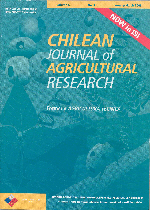
|
Agricultura Técnica
Instituto de Investigaciones Agropecuarias, INIA
ISSN: 0365-2807
EISSN: 0365-2807
Vol. 61, No. 2, 2001, pp. 120-128
|
 Bioline Code: at01015
Bioline Code: at01015
Full paper language: English
Document type: Research Article
Document available free of charge
|
|
|
Agricultura Técnica, Vol. 61, No. 2, 2001, pp. 120-128
| en |
Genetic Improvement of Bread Wheat (Triticum AestivumL.) in the South Central Zone of Chile. III. Protein Content, Production and Sedimentation Volume of Winter, Alternative and Spring Wheats
Mellado, Mario Z.
Abstract
Four field experiments with ten winter and alternative varieties (group 1) and four experiments with eleven spring wheat varieties (group 2), were carried out to assess grain protein percentage, grain production and sedimentation volume. The tested genotypes were developed at the Quilamapu Wheat Breeding Program, Institute of Agricultural Research, INIA. Lilifen was the first breed variety improved in group 1, and Mexifen in group 2; as such both were used as references. The experiments were carried out in Andisoil soils at the Santa Rosa Experimental Field, Chillán, Chile, from 1995 to 1998. The mean protein percentage of varieties of groups 1 and 2 were 9.6 and 10.8%, respectively. The average protein production in group 1 was 894.6 kg ha-1, while in group 2 was 968.4 kg ha-1. The average sedimentation values were 3.4 mL in group 1 and 4.3 mL in group 2. With regard to varieties, results showed that breeding work carried out between 1968 and 1993 was more successful at improving protein content rather than quality.
Keywords
wheat quality, grain protein, sedimentation SDS
|
| |
| pt |
Mejoramiento de Trigos Harineros (Triticum AestivumL.) en la Zona Centro sur de Chile. III. Contenido y Producción de Proteina, y Volumen de Sedimentación en Trigos Invernales, Alternativos y Primaverales.
Mellado, Mario Z.
Resumo
Se realizaron cuatro experimentos de campo con diez variedades de trigos de invierno y hábito alternativo (grupo 1), y cuatro experimentos con once variedades de trigos de primavera (grupo 2), para evaluar el porcentaje y producción de proteína del grano, y el volumen de sedimentación. Los genotipos fueron desarrollados en el Proyecto de Mejoramiento de Trigo del Instituto de Investigaciones Agropecuarias (INIA), Centro Regional de Investigación Quilamapu. Lilifén fue la primera variedad mejorada en el grupo 1, y Mexifén en el grupo 2; por lo tanto ambas fueron usadas como referencia. Los experimentos se llevaron a cabo en suelos Andisoles del Campo Experimental Santa Rosa (INIA), Chillán, Chile, desde el año 1995 a 1998. Los porcentajes medios de proteína de las variedades de los grupos 1 y 2 fueron 9,6 %, y 10,8%, respectivamente. El promedio de producción de proteína de las variedades del grupo 1 fue 894,6 kg ha-1 mientras que en el grupo 2 este valor fue 968,4 kg ha-1. Los valores medios para sedimentación fueron 3,4 mL en el grupo 1 y 4,3 mL en el grupo 2. En relación a las variedades, los resultados demostraron que el trabajo de mejoramiento de trigo realizado entre 1968 y 1993 fue más exitoso en mejorar el contenido de proteína del grano que su calidad
Palavras-chave
calidad del trigo, proteína del grano, sedimentación SDS
|
| |
© Copyright 2001 - Instituto de Investigaciones Agropecuarias, INIA (Chile)
Alternative site location: http://www.inia.cl/at/agritec.htm
|
|
